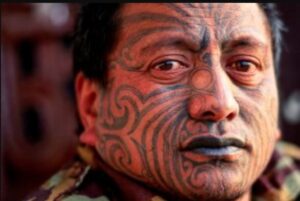
To continue, the practice of body modification is ancient, we see this through the mummified skin and ancient art found worldwide. The tattoos we find are thought to be originally used to signify a person’s status, achievements, and tribal affiliations. We see this tradition carry forward to gang tattoos, which first emerged as symbols of identity and belonging. In addition, these tattoos often helped mark ethnic or territorial lines within early gang formations. For example, the Maori tribes of New Zealand used ‘moko’ tattoos as indicators of tribal identity and social status, this practice was then reflected in the early use of tattoos in gangs to signify membership and allegiance.

Notably, in the 20th century, the narrative of gang tattoos began to evolve in our prison systems. Here, tattoos began to function as a coded language among the inmates that showed a prisoner’s criminal history, affiliations, and roles. The Russian criminal tattoos are a prime example as they indicate a person’s status as a high-ranking criminal. Similarly, American gangs like the Mexican Mafia or street gangs such as the Crips and Bloods use tattoos not just as identifiers but also to project their power and control their image to the outside world. They are essentially communicating threats, warnings, and achievements through visual language. Some notable tattoos include the teardrops under one eye, often associated with murder, and spider webs, which can represent time spent in prison or with a gang. These tattoos reinforce the gang’s values, celebrate significant events, and sometimes provide a sense of respect among the members.
A problem with these tattoos is that they can also bring about obstacles for former gang members who are seeking to return to mainstream society. Efforts to support these individuals include safe locations to remove gang tattoos. A business in Los Angeles named Homeboy Industries offers this service as a part of a broader rehabilitation program including job training and mental health support. These programs also try to spread awareness to others so that more people recognize the powerful role these tattoos play in gang identity and the barriers that they can create for former members seeking change. One reason awareness of gang tattoos is important is because they often influence cultural and social trends among the youth. Particularly, elements of gang tattooing have been appearing in mainstream fashion and social media. This cultural appropriation highlights a disconnect between the aesthetic appeal of these tattoos and their serious, often dangerous, indications. It reflects a larger societal fascination with the ‘outlaw’ image, which is frequently romanticized even though it is related to gang life.
To conclude, the history and evolution of gang tattoos offer a lens that we can use to examine the broader themes of identity, belonging, and the human condition. These tattoos are often a vivid symbol of loyalty and defiance but also pose significant challenges for those who wish to leave that life behind. By understanding the rich symbolism and complex roles of gang tattoos, we can better address the challenges they present in the journey toward social reintegration and personal transformation. In addition, by spreading awareness of what these tattoos symbolize, we can close the gap between the aesthetic appeal and the dangerous implications of gang tattoos.







Tattoos have long been a form of expression and story-telling and it’s interesting to see the many different ways people have used tattoos for. I think the stigma around tattoos is fairly outdated but are now being far more accepted with some exceptions of course. I never really thought about how hard it must be for those who are trying to leave their gang affiliation behind but have permanent proof of it on their bodies. I think it’s great that there are places where people can go to, to get their tattoos removed safely. Another thing I thought about was of those who are gang “wannabes” and get tattoos that resemble those of gangs or straight up copy them. I think that’s a very serious problem that some people don’t seem to realize. Another thing I’ve seen online is of children getting gang tattoos tattooed on them because they were born into it. It’s so disheartening seeing that because those kids are never going to have a choice of who they want to be.
Hello Pedro, your article offers a strong exploration of tattooing’s long history and its evolution into the modern symbolism of gang tattoos. It clearly shows how a practice once rooted in status and identity within ancient societies has transformed into a coded language of power, loyalty, and intimidation. The use of concrete examples added to this piece with discussing Russian prison tattoos, American gangs, and recognizable designs like teardrops and spider webs, which overall make the cultural significance far more tangible. The section on rehabilitation, including programs like Homeboy Industries, adds valuable depth by highlighting both the difficulties faced by former gang members and the positive role of tattoo removal in reintegration. One part of this that could be developed further is the theme of cultural appropriation, since the use of gang-related imagery in fashion and on social media raises important questions about society’s fascination with the “outlaw” aesthetic. To conclude, this piece succeeds in connecting the historical roots of tattooing with its current social meanings, blending cultural analysis with social awareness.